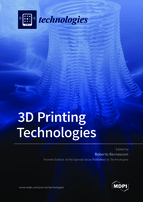3D Printing Technologies
A special issue of Technologies (ISSN 2227-7080). This special issue belongs to the section "Manufacturing Technology".
Deadline for manuscript submissions: closed (31 March 2021) | Viewed by 18044
Special Issue Editor
Interests: microfabrication; electrochemistry; surface treatments
Special Issues, Collections and Topics in MDPI journals
Special Issue Information
Dear Colleagues,
3D printing is rapidly revolutionizing the way industrial production has always been intended. Its potential to produce intricate parts starting from a computer-aided design makes it one of the main pillars for industry 4.0. Furthermore, additive manufacturing finds applications in virtually all production fields. As a natural consequence of these considerations, research is primarily focused on the development of novel materials and techniques for 3D printing.
In view of the growing industrial importance of additive manufacturing, this Special Issue is intended to report cutting edge advances in this promising technology. It is open to both original research articles able to advance knowledge on 3D printing and to reviews meant to take stock of state-of-the-art literature.
Possible topics include: 3D printing of soft and biomaterials, additive manufacturing for electronics and metamaterials, new materials for 3D printing (metals, composites, hard materials, ceramics, etc.), multi-material 3D printing, integration of 2D (inkjet printing, screen printing, etc.), and 3D printing technologies, metallization for 3D printing, 3D printing for microfabrication, numerical and finite elements modelling of additive manufacturing processes.
Dr. Roberto Bernasconi
Guest Editor
Manuscript Submission Information
Manuscripts should be submitted online at www.mdpi.com by registering and logging in to this website. Once you are registered, click here to go to the submission form. Manuscripts can be submitted until the deadline. All submissions that pass pre-check are peer-reviewed. Accepted papers will be published continuously in the journal (as soon as accepted) and will be listed together on the special issue website. Research articles, review articles as well as short communications are invited. For planned papers, a title and short abstract (about 100 words) can be sent to the Editorial Office for announcement on this website.
Submitted manuscripts should not have been published previously, nor be under consideration for publication elsewhere (except conference proceedings papers). All manuscripts are thoroughly refereed through a single-blind peer-review process. A guide for authors and other relevant information for submission of manuscripts is available on the Instructions for Authors page. Technologies is an international peer-reviewed open access monthly journal published by MDPI.
Please visit the Instructions for Authors page before submitting a manuscript. The Article Processing Charge (APC) for publication in this open access journal is 1600 CHF (Swiss Francs). Submitted papers should be well formatted and use good English. Authors may use MDPI's English editing service prior to publication or during author revisions.
Keywords
- 3D printing
- additive manufacturing
- industry 4.0
- process development
- process integration
- numerical modelling






